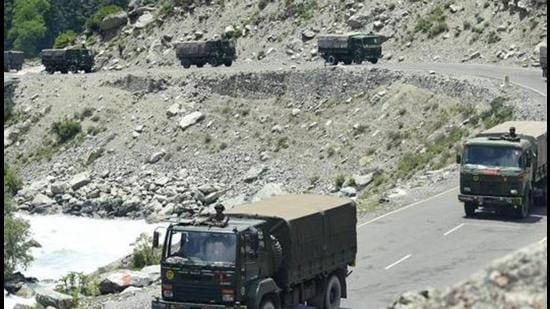China building bridge across Pangong Lake: Satellite imagery
The bridge – which spans a narrow section of the 134 km lake and is almost complete – is expected to enhance road connectivity for the PLA in the area and allow the speedy movement of both troops and heavy equipment
China has played up the hoisting of its national flag by soldiers at Galwan Valley as part of New Year celebrations as satellite imagery emerged of a new bridge being built by the Chinese to link both banks of Pangong Lake, highlighting the continuing tensions in the Ladakh sector.

The messaging by China’s state-run media regarding the celebrations by Chinese troops at Galwan Valley was in marked contrast to images shared by the Indian side on January 1 of troops of the two countries exchanging sweets and greetings on New Year at several locations along the Line of Actual Control (LAC).
The state media shared two videos – one showing People’s Liberation Army (PLA) troops training on the Tibetan plateau saluting the national flag, and another more pointed one of PLA soldiers sending New Year greetings to the Chinese people from Galwan Valley, “near the border with India”, while standing under Mandarin characters painted on a rock that read: “Never yield an inch of land.”
A report on New Year celebrations by the nationalist Global Times tabloid mentioned the raising of the national flag at places across China in its opening paragraph, but named only two locations – Hong Kong special administrative region and the Galwan Valley. Representatives of the state media tweeted the flag raised at Galwan was special as it once flew over Tiananmen Square in Beijing.
These videos were followed by the emergence of satellite imagery that showed a new bridge being constructed by the Chinese side to link the north and south banks of Pangong Lake. Twitter user Damien Symon, who uses the handle @detresfa_, posted an image of the bridge, being built in territory held by the Chinese side, that would cut the distance between several PLA positions on both banks of the lake.
The bridge – which spans a narrow section of the 134 km lake and is almost complete – is expected to enhance road connectivity for the PLA in the area and allow the speedy movement of both troops and heavy equipment.
There was no immediate response to these developments from Indian officials. Indian and Chinese troops have been locked in a face-off in Ladakh sector of the LAC since May 2020. Following the disengagement of frontline troops on the banks of Pangong Lake and at Gogra last year, the two sides have been unable to make headway on de-escalation at several other friction points such as Depsang.
People familiar with the developments said on condition of anonymity that the video showing Chinese troops in the Galwan Valley appeared to have been made in an area held by the Chinese side. They noted that it was not made in the so-called two-kilometre “buffer zone” created around the scene of a brutal clash at Galwan Valley in June 2020 that resulted in the death of 20 Indian soldiers and at least four Chinese troops.
“They’ve deliberately not shown the bend of the Galwan river, which is with the Indian side,” said one of the people cited above. Another person added that the video, though shared widely by the Chinese media on January 1, appeared to have been shot some time ago as there is no snow visible on the nearby mountains.
The people said that the new Chinese bridge spanning the Pangong Lake appeared to be located about 40 km from Finger 4 and would drastically reduce the distance between several PLA locations. They noted that India too is developing infrastructure on its side in this region and said the new Chisumle-Demchok road at Umling pass, located at a height of more than 19,000 feet in southern Ladakh, will allow troops to be speedily moved to several strategic positions on the Indian side.
Maj Gen (retired) Ashok Kumar, a visiting fellow at the Centre for Land Warfare Studies (CLAWS), said the combination of China’s new land border law and the accelerated construction of infrastructure and “Xiaokong” or model villages along and inside disputed regions has created “conditions for a militarised solution to the boundary issue”.
“Frankly, China’s political establishment wishes to win wars without fighting in the real sense. They’re mobilising public opinion, including in the opposing nation and resorting to psychological warfare to highlight their own strengths and beating down the opponent,” he said.
“The new boundary law is the manifestation of a long-standing Chinese ploy of using ‘lawfare’ for gaining territorial concessions. The Chinese use legal norms to highlight what they believe is right in legal terms, and they are not in a hurry to resolve disputes unless the resolution is favourable to them,” Kumar added.






